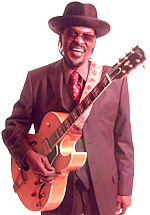
Go-Go: From Funk to Hip-Hop
A shift from funk to hip-hop-influenced go-go occurred during the late 1980s. The most noticeable consequence was the spareness of the instrumentation utilized by most bands. Funk and soul influenced the pioneering go-goers; brass and reed instruments, along with entire rhythm sections (as employed, for example, by Trouble Funk or Mass Extinction), became standard. In addition, these groups, especially Chuck Brown's, often included jazz musicians who had the freedom to create tenor saxophone or trumpet solos during these long sets. Younger and newer bands such as Junkyard Band and Backyard Band matured in the years after groups gave up brass and reeds in favor of electronic keyboards and synthesizers. Live and studio recordings by groups such as Backyard Band and Junkyard Band illustrate this sound. However, true to their heritage, all the younger bands maintained the expanded percussion section. More recent go-go bands, such as Jigga, have remained very much in touch with both the sound and the essence of hip-hop in their structure: a multi-faceted vocal component backed by dense layers of percussion.

Chuck Brown with his signature blonde Gibson ES-175
"Lead Talkers" are another go-go innovation directly linked to rap. The lead talker-a term that seems unique to Washington, DC-is essentially the frontman, the primary vocalist, and the main rapper for a group. Singing is essential, but it takes a backseat to rapping in more recently formed go-go bands-in much the same way as hip-hop. Bands ranging from Rare Essence to the Northeast Groovers have designated one of their members as the lead talker.
Early in the twenty-first century, go-go remained entrenched in Washington, DC, as a vibrant form of Black popular music. It has attracted a cadre of hardcore fans ranging in age from their early teens to their fifties, as well as people who have come to go-go on a more casual basis. But the one constant (besides "the beat" and Chuck Brown) has been that go-go has remained at the heart of and speaks uniquely for the city's Black community. As a result, as Sarah Godfrey discusses in the article " The History of Go-Go: A 6-Step Guide to the Essentials," many go-go bands have longevity performing go-go music.
Moreover, young people are instrumental in keeping the go-go scene alive by dancing and using dance and go-go music as forms of outreach to encourage younger generations to be proud of their Washingtonian heritage, as evidenced by the PBS special about dance and the go-go music scene in Washington, DC (Godfrey 2019, n.p.).







